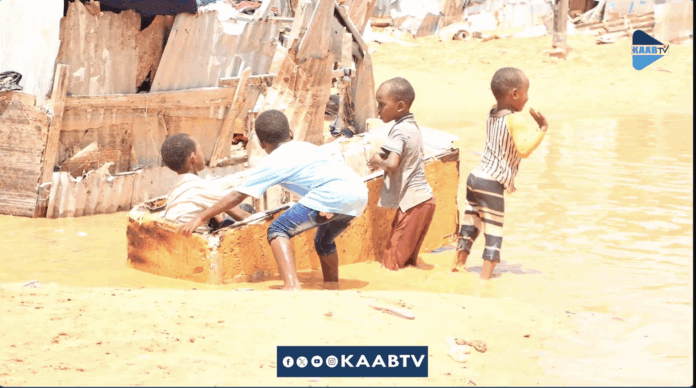GAROWE (KAAB TV) – At least 17 people have died across Somalia due to flash flooding caused by seasonal Gu rains (April–June), which began in mid-April and have since inundated southern and central parts of the country, according to authorities and humanitarian agencies.
The Banadir Regional Administration confirmed that 11 of the fatalities occurred in Mogadishu, where heavy rainfall on May 9–10 led to widespread damage.
The UN Office for the Coordination of Humanitarian Affairs (OCHA) reported that more than 84,000 people have been affected nationwide, though some areas remain dry—particularly in Puntland and Somaliland—where drought conditions continue to impact pasture and water availability.
In Mogadishu’s Kahda and Daynile districts, assessments by the Camp Coordination and Camp Management (CCCM) Cluster found that flash floods affected over 3,810 households (approximately 22,500 people), displacing 430 households (2,580 people).
Six major roads in the capital were submerged, operations at the international airport were briefly suspended, and key humanitarian supplies were at risk after a storage container for an international agency was partially submerged.
In addition to Mogadishu, movement and logistics have been disrupted along key supply corridors in Belet Weyne, Baidoa, Doolow, and the Mogadishu–Kismayo coastal road.
Hirshabelle State: Flood Emergency in Middle Shabelle and Hiraan
On May 12, heavy downpours in Middle Shabelle and Hiraan regions triggered flash floods in Jowhar and Balcad districts.
According to the UNHCR Protection and Solutions Monitoring Network (PSMN), approximately 16,200 people in Jowhar were impacted, including displaced persons whose shelters and sanitation facilities were destroyed.
On May 16, the Shabelle River overflowed in Baarey village, flooding farmland and prompting new displacement in nearby Lebiga and Xaanshooley villages.
The Hirshabelle State authorities said floods displaced at least 1,450 households (8,700 people) in Jowhar IDP camps and another 620 households (3,720 people) in Balcad.
The overflowing Shabelle River also cut off the road connecting Xawaadley to Jowhar and Balcad, forcing hundreds of families to flee to Xawaadley town.
Galmudug State: Lightning Strike and Health Concerns
Moderate rains fell on May 9 in Dhuusamarreeb and Cabudwaaq. A lightning strike in Cabudwaaq’s main market reportedly killed a woman and injured two others.
Another fatality was reported in Qaansole village near Dhuusamarreeb.
Health officials at Gaalkacyo South Referral Hospital have recorded a rise in suspected Acute Watery Diarrhoea (AWD)/cholera cases, with 22 patients currently admitted.
Jubaland State: Shelter Damage and Displacement
In Baardheere district, heavy rains on May 5 damaged shelters in 54 IDP sites. In Buurdhuubo, local authorities and humanitarian partners reported that 3,740 households were affected, with shelters of over 2,000 households severely damaged.
Some displaced families have sought refuge with host communities.
Puntland State: Localized Floods, Widespread Drought
While most of Puntland remains dry, flash floods in mid-April affected 27,000 people in Bari and Nugaal regions.
The flooding subsided within days, and most affected residents have returned to normal life.
Light rains have since been received, providing limited relief for nomadic pastoralist communities that make up over 70 percent of the region’s population.
Somaliland: Limited and Uneven Rainfall
Partners report that rains in Somaliland have been minimal and below normal. While Hargeisa received moderate rains in early May, no precipitation has been recorded since May 13.
The ongoing dry conditions, particularly in Awdal region, continue to impact pastoralist livelihoods.
South West State: Rising River Levels and Flood Threat
The Shabelle River has reached critical levels in Afgooye district, posing a high risk of flooding.
Already, 273 households in surrounding villages such as Balguri, Aaytire, Damaley, Raqayle, and Siigaale have been affected. In Baidoa, flash floods since mid-April have impacted internally displaced persons in 78 sites, with at least 760 households (3,193 people) affected.
Banadir Region: Infrastructure Damage and Urgent Humanitarian Needs
The Banadir Regional Administration reported extensive damage from the recent floods in Mogadishu, including the submergence of at least 200 houses and damage to nine roads.
Officials have issued an urgent appeal for humanitarian assistance for displaced and affected communities.

According to the FAO Somalia Water and Land Information Management (SWALIM) unit, rainfall is expected to decrease in the coming days, with only light showers forecasted for Lower Juba, Hiraan, and Mudug.
Most of Puntland, Somaliland, and parts of central and southern Somalia are expected to remain dry.
Despite the destruction, the rains have improved water and pasture availability in many areas, boosting agricultural activity and providing much-needed relief from prolonged dry conditions.
However, humanitarian partners warn that immediate support is critical for those displaced or affected by the flooding.
–


